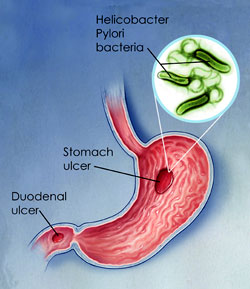 Helicobacter Pylori (H. pylori) is bacteria that causes infection of the stomach. Generally, it occurs when a person swallows the bacteria in food, fluid or uses contaminated utensils. In many cases, there are no symptoms and patients can have an infection without knowing it. H. pylori is related directly to the development of diseases such as dyspepsia (heartburn, bloating and nausea), gastritis (inflammation of the stomach), and ulcers in the stomach and duodenum. It is also linked to stomach cancer.
Helicobacter Pylori (H. pylori) is bacteria that causes infection of the stomach. Generally, it occurs when a person swallows the bacteria in food, fluid or uses contaminated utensils. In many cases, there are no symptoms and patients can have an infection without knowing it. H. pylori is related directly to the development of diseases such as dyspepsia (heartburn, bloating and nausea), gastritis (inflammation of the stomach), and ulcers in the stomach and duodenum. It is also linked to stomach cancer.
FAQs
The infection can be diagnosed during an endoscopy, a visual examination of the stomach through a thin, lighted flexible tube. It can also be diagnosed through a breath, stool, or blood test.
The bacteria may lead to gastritis, dyspepsia, or stomach ulcers, and is also linked to stomach cancer and lymphoma. Each condition has distinct characteristics and treatments:
- Gastritis and dyspepsia— Symptoms include discomfort, bloating, nausea and vomiting. You may also have symptoms that suggest ulcers (see below). The symptoms are often relieved temporarily by antacids, milk, or medications that reduce stomach acidity.
- Stomach ulcers — Symptoms include burning or pain in the upper abdomen, usually occurring about an hour or so after meals or during the night when lying down. In addition to the treatments mentioned below, your physician will usually prescribe antibiotic therapy to see if eradication of the infection relieves symptoms.
- Duodenal ulcers — Research shows that more than 90 percent of all people who develop duodenal ulcers also have H. pylori infection in the stomach. It is fairly easy to heal duodenal ulcers with the strong, acid-reducing medicines available. However, the ulcers will usually recur unless the H. pylori infection is also cleared from the stomach.
- Stomach cancer and lymphoma — Most people with H. pylori infection do not develop cancer. However, if the infection is present for a long time, it is more likely that cancer will occur.
Several antibiotic drugs are used simultaneously to prevent the bacteria from developing resistance to any one of them. Additional treatments are also used to target any other conditions that may be present.